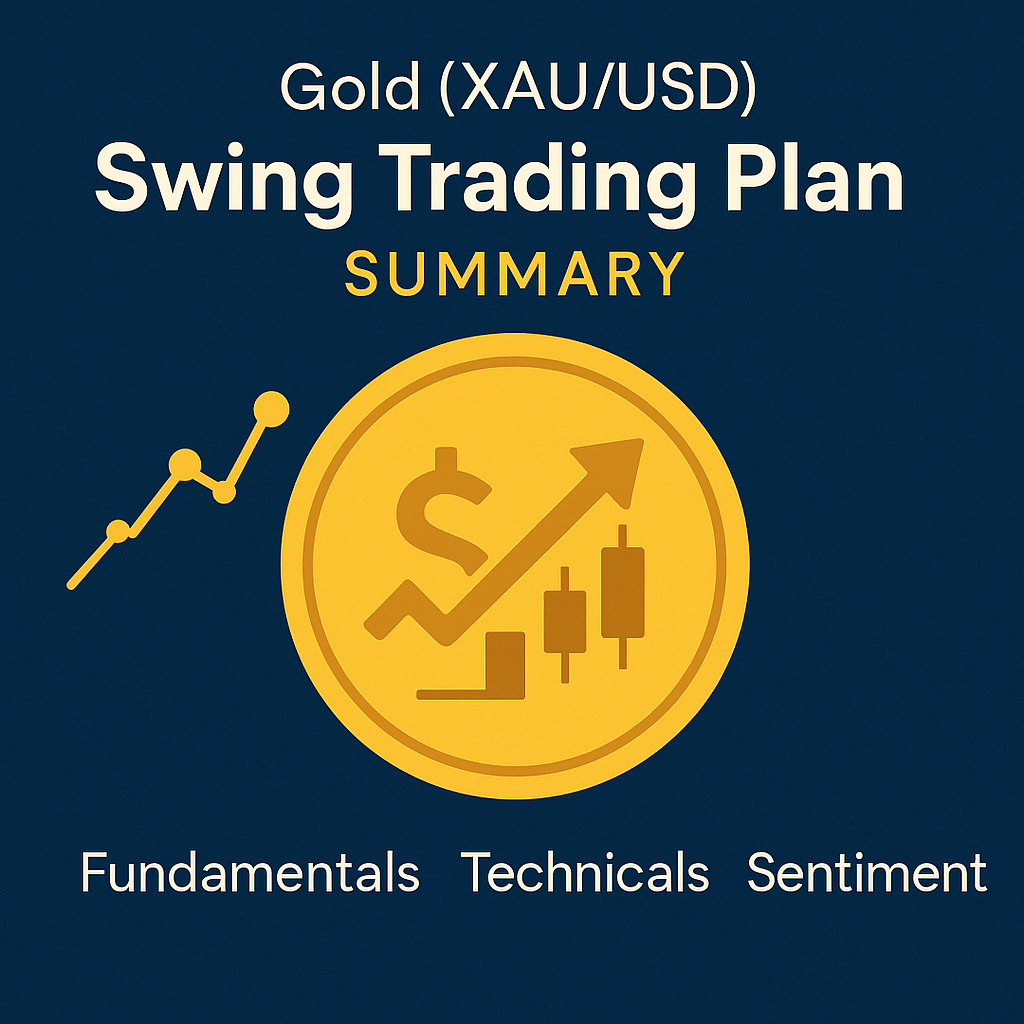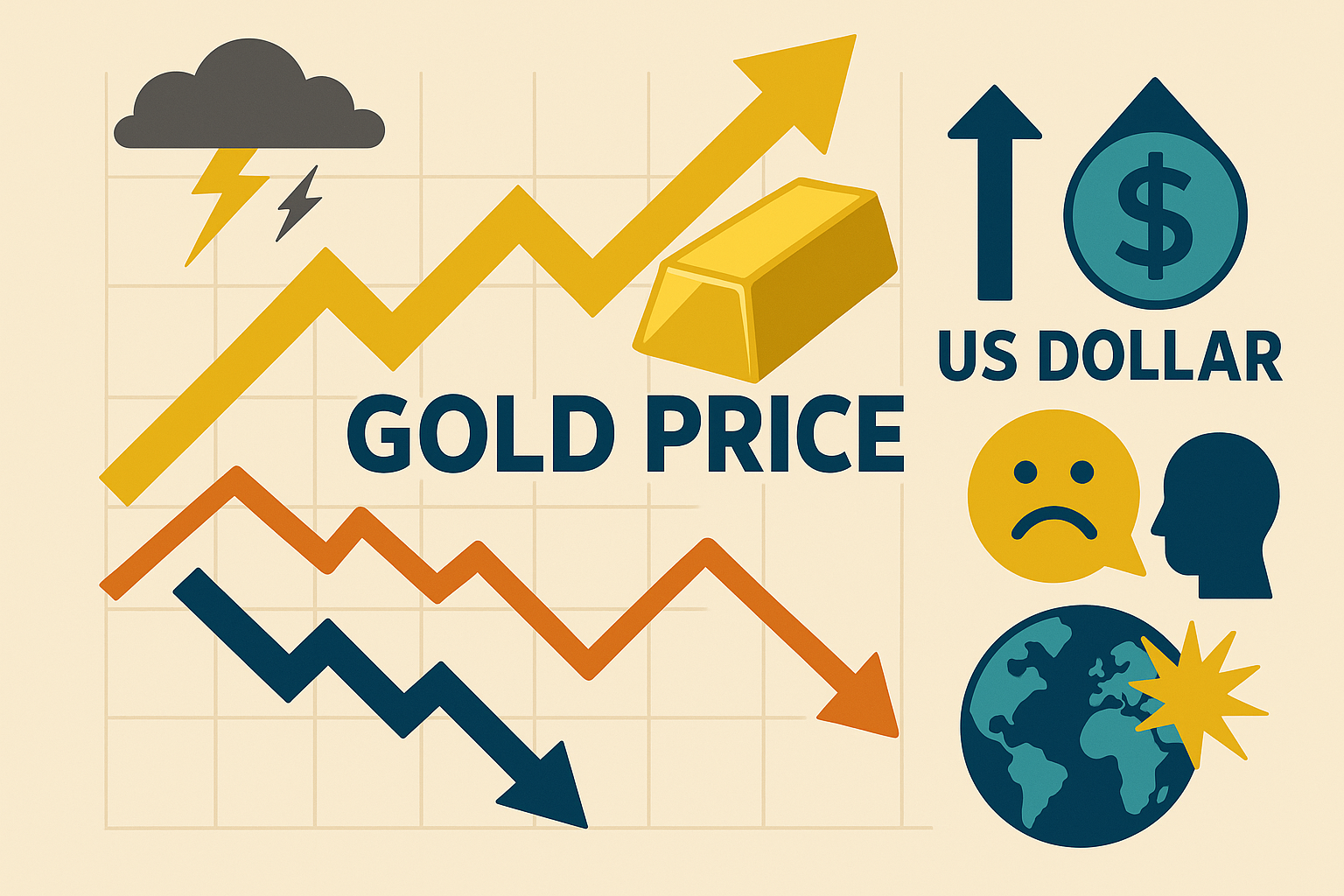Gold (XAU/USD) Swing Trading Plan
Executive Summary: Gold (XAU/USD) Swing Trading Outlook
Gold (XAU/USD) maintains a robust bullish momentum, primarily driven by persistent global geopolitical tensions, a decelerating global economic growth trajectory, and sustained accumulation by central banks worldwide. While major central banks, such as the European Central Bank (ECB) and the Bank of Japan (BoJ), are either actively easing monetary policy or gradually normalizing it, the Federal Reserve's cautious stance, influenced by sticky inflation and trade policy uncertainties, introduces a nuanced dynamic. From a technical perspective, current indicators suggest a period of consolidation or minor pullbacks near gold's all-time highs. This presents strategic opportunities for swing traders to establish long positions on dips, aligning with the broader upward trend. The prevailing market sentiment and fundamental tailwinds indicate that any short-term weakness is likely to be a strategic buying opportunity. The recommended trading bias for the coming week is Cautiously Bullish, favoring long positions initiated on pullbacks to key support levels.
I. Macroeconomic & Fundamental Drivers for Gold
A. Global Economic Growth & Inflation Outlook
The global economy is facing a significant slowdown, with growth projected to decelerate to 2.3% in 2025. This rate represents the slowest pace recorded since 2008, excluding periods of outright global recessions.1 Projections indicate that growth forecasts have been revised downwards for nearly 70% of all economies, spanning various regions and income groups.3 This deceleration is largely attributed to heightened trade tensions and a pervasive sense of policy uncertainty, factors that are also notably impacting developing economies, where growth rates have seen a steady decline over the past three decades.
Despite this general slowdown, global inflation is projected to average 2.9% in 2025, remaining above pre-pandemic levels.2 While a moderation in food and energy prices is anticipated to temper overall inflationary pressures, the increasing prevalence of global trade restrictions, particularly tariffs, is identified as a primary upside risk to global inflation.
The United States presents a distinct divergence from the global inflation trend. Unlike most other major economies where inflation is expected to lose steam, the U.S. is projected to see an acceleration, potentially peaking between 3% and 3.5% in the third quarter of 2025. This acceleration is largely driven by companies passing tariff-related costs onto consumers and potential labor shortages resulting from immigration restrictions. The wide range of U.S. Consumer Price Index (CPI) predictions among economists, spanning from 1.8% to 3.1%, underscores the considerable uncertainty surrounding the full impact of these factors.5
The concurrent trends of slowing global economic growth and persistent, elevated inflation, particularly the tariff-driven pressures in the U.S., collectively point towards a potential environment characterized by both stagnation and inflation. This economic backdrop is historically supportive of gold, as it erodes the purchasing power of fiat currencies and heightens overall economic uncertainty, thereby stimulating demand for safe-haven assets.
Regional Divergence
A significant divergence in inflationary pressures is observed globally. While a general disinflationary trend is present in many regions, the U.S. is grappling with unique, domestically-driven inflationary forces, predominantly stemming from tariffs and labor market dynamics. This creates distinct policy challenges for central banks and influences currency valuations. Unlike other major economies where central banks might have greater flexibility to ease monetary policy in response to falling inflation, the Federal Reserve faces a more complex balancing act. This difference in monetary policy outlook can influence the U.S. Dollar's strength, which in turn impacts gold prices.
In the Euro area, the primary impediment to growth is lower exports, leading to modest growth projections of 0.9% in 2025. Inflation in the Eurozone is expected to fall below the ECB's 2% target during 2025. China's economy is projected to grow by 4.5% in 2025, but it continues to contend with deflationary pressures and ongoing weakness in its housing sector, factors further exacerbated by U.S. tariffs.
B. Central Bank Monetary Policy Expectations
The monetary policy stances of major central banks present a varied landscape, significantly influencing global liquidity and, consequently, gold prices.
The **Federal Reserve** in the U.S. has maintained its federal funds rate unchanged at 4.25%-4.50% during its May and June 2025 meetings, adopting a cautious "wait-and-see" approach.6 Despite some strategists anticipating rate cuts in the latter half of 2025, the Fed's primary focus remains on containing inflation. Current projections suggest the Fed will hold rates steady until March 2026, with substantial rate cuts only expected by the end of 2026.5
In contrast, the **European Central Bank (ECB)** is firmly engaged in an easing cycle. It implemented a 25-basis point rate cut in April 2025, bringing the deposit facility rate to 2.25%.4 Forecasts indicate that the ECB will continue its easing cycle, potentially reducing the policy rate to 1.50% by December 2025.7
The **Bank of Japan (BoJ)** raised its key interest rate by 0.25% to approximately 0.50% in late January 2025 and is expected to continue raising rates due to rising wages and a strategic effort to correct the yen's depreciation.8, 9
Policy Outlook Overview
| Economic Indicator | U.S. Outlook (2025) | Euro Area Outlook (2025) | Japan Outlook (FY2025) | Global Outlook (2025) |
|---|---|---|---|---|
| GDP Growth Forecast | 1.5% | 0.9% | N/A (implied moderate) | 2.3% |
| CPI/Inflation Forecast | 3-3.5% peak Q3 | 2.0%, 2.3% | 2.4% | 2.9% |
| Central Bank Policy Rate | Hold until Mar 2026 | Ease to 1.50% by Dec 2025 | Continue raising from 0.50% | N/A (diverse) |
| Key Policy Driver | Inflation containment, tariffs | Falling inflation, weak growth, trade uncertainty | Wage-price cycle, yen depreciation | Trade tensions, policy uncertainty |
C. Geopolitical Landscape & Safe-Haven Demand
The escalating geopolitical landscape has emerged as a significant catalyst for gold's recent price surge. The ongoing Israel-Iran war and the protracted Ukraine-Russia conflict are identified as primary drivers, substantially fueling demand for safe-haven assets.10, 11 The intensification of the Israel-Iran conflict in the second week of June 2025 has notably heightened fears of a broader regional war.12 Gold has consistently reaffirmed its historical role as a reliable hedge against geopolitical risk.15
Geopolitical instability is not merely a transient market factor but has evolved into a persistent, structural tailwind for gold prices. Even in periods of temporary de-escalation, the inherent underlying tensions ensure a sustained baseline demand for safe-haven assets. This indicates that while short-term dips might occur, the fundamental demand for gold as a hedge against global instability remains robust, suggesting that such dips are likely buying opportunities for swing traders.
D. Gold-Specific Market Dynamics
- Central Bank Accumulation: Central banks, particularly in China and Russia, are continuing their aggressive accumulation of physical gold as a strategic move towards de-dollarization. 95% of central banks anticipate an increase in global gold reserves, with a record 43% planning to augment their own holdings. This sustained demand is projected to continue throughout 2025, marking the 16th consecutive year of net gold buying for the sector. This consistent demand serves as a crucial factor in dampening downside price volatility, thereby supporting a higher price floor for gold.13
- ETF Inflows: After a 3.5-year period of outflows, physically-backed gold ETFs have witnessed a significant resurgence, attracting 226 tonnes in Q1 2025 alone. This signals a paradigm shift in investment sentiment and suggests considerable room for further expansion of gold ETF holdings, as global tonnage is still down approximately 20% from its 4Q'20 peak.13
- Global Debt: Record high global sectoral debt, exceeding US$324 trillion in Q1 2025 with nearly 30% on government balance sheets, is a structural issue unlikely to be resolved in the near term. This elevated debt environment inherently supports a "higher for longer" gold price regime.13
Gold's current appeal extends beyond its traditional role as a safe-haven asset. It is simultaneously acting as a crucial hedge against persistent inflation, a store of value amidst escalating global debt, and a beneficiary of anticipated monetary easing from major central banks. This multi-faceted role broadens its investment appeal and significantly strengthens its long-term bullish case.
II. Gold (XAU/USD) Technical Analysis
A. Current Price Action & Trend Assessment
The overarching trend for gold remains unequivocally bullish, evidenced by remarkable year-over-year gains of 47.37% as of June 16, 2025.19 After approaching its all-time high of $3,451 and reaching a peak of $3,499.88 on April 22, 2025, gold has experienced a period of consolidation.17 This short-term weakness is attributed to a temporary easing of safe-haven demand. The current price action indicates a healthy pullback within a larger, intact bullish trend, presenting a strategic opportunity for swing traders to initiate long positions at more favorable levels.
B. Key Support and Resistance Levels
Understanding key price levels is fundamental for defining entry, exit, and risk management strategies. The convergence of these levels from various technical analyses strengthens their validity and predictive power.
Figure 1: Key Technical Support and Resistance Zones for XAU/USD.
C. Technical Indicators Overview
A review of various technical indicators provides a comprehensive picture of gold's current market state. The combination of signals indicates that while the long-term trend is bullish, the immediate price action is likely to be choppy or corrective, making the market ripe for buying dips.
- Relative Strength Index (RSI): Has retreated to a neutral territory (around 52) from overbought levels, but remains above 50, indicating a dominant bullish bias.14, 19
- MACD & Stochastic: Both indicators are turning downwards, implying that bullish momentum is waning and a period of consolidation may be underway.14, 19
- Moving Averages (MA): The 50-day ($3,319.51) and 200-day ($2,905.33) MAs are positioned well below the current price, acting as dynamic support levels.19
D. Relevant Chart Patterns and Price Behavior
The appearance of short-term bearish candlestick patterns (Shooting Star, Bearish Engulfing) near resistance levels, while larger, intact bullish structures (cup-and-handle, ascending channel) persist, strongly suggests that the market is likely to undergo a near-term pullback.17, 18 This correction is expected to occur before a resumption of the broader uptrend, thereby creating optimal entry points for swing traders.
III. Market Sentiment & Analyst Consensus for Gold
The overwhelming consensus among major financial institutions for significantly higher gold prices in late 2025 and 2026 provides strong validation for a long-term bullish bias. This institutional backing suggests that any short-term technical weakness is likely to be absorbed by strategic, long-term buyers.
Figure 2: Gold Price Forecasts from Major Institutions (2025-2026).
A. Short-term and Long-term Price Forecasts
The prevailing sentiment among most analysts is strongly bullish for gold, with predictions for a significant rise in prices by the end of 2025, ranging from $3,560.59 to $3,925.39.16
- Goldman Sachs: Projects gold reaching $3,700/oz later in 2025, with further appreciation to $4,000 by mid-2026.16
- Bank of America: Maintains an ambitious $4,000/oz target for 2026.16
- JPMorgan: Projects prices remaining above $3,200 through 2026, with a Q4 2025 average of $3,675/oz.16
- SSGA (State Street): Base case of $3,100-$3,500/oz; bull case of $3,500-$3,900/oz for this year.13
B. Contrasting Views and Potential Headwinds
While the overall sentiment is bullish, it is important to consider contrasting views. **Citigroup** stands out as a notable outlier, projecting a bearish outlook for gold in late 2025 and into 2026, centering on an anticipated fundamental shift in macroeconomic conditions.20 Potential headwinds include a strengthening U.S. Dollar, a more hawkish Fed than expected, or a significant de-escalation of global trade tensions.
IV. Conclusions & Swing Trading Plan for the Coming Week
The comprehensive analysis of fundamental, economic, and technical factors points to a cautiously bullish outlook for gold (XAU/USD) in the coming week. The confluence of global economic deceleration, persistent inflation (particularly in the U.S. due to tariffs), ongoing geopolitical tensions, and robust structural demand from central banks and ETF inflows establishes a strong long-term bullish foundation for gold. While short-term technical indicators suggest a period of consolidation or minor correction from recent highs, these pullbacks are viewed as strategic entry opportunities within the broader uptrend.
Recommended Swing Trading Plan for XAU/USD
- Overall Bias: Cautiously Bullish
- Strategy: Buy on Dips
- Primary Entry Zone: $3,300 - $3,310
- Secondary Entry Zone: $3,280 - $3,296
- Take Profit 1 (Short-Term): $3,400 - $3,410
- Take Profit 2 (Medium-Term): $3,440 - $3,450
- Stop Loss: Below $3,251 for primary entry. A close below $3,140 would invalidate the long-term uptrend.
Risk Management Considerations:
Adhere to strict risk management principles, risking no more than 1-2% of trading capital on any single trade. Be aware that geopolitical events can cause sudden volatility spikes. Always wait for clear confirmation of support holding before entering a long position. Avoid anticipating bounces.
About the Authors
Md Mohibullah
Chief Strategist & Editorial Director
As Chief Strategist at Fundure Research, Mohibullah architects the conceptual framework for our market analysis. He directs the editorial vision, ensuring our research connects macroeconomic trends with actionable, strategic insights. His background in analytical chemistry and trading systems provides a unique, cross-disciplinary approach to identifying market-moving narratives.
Finian
Quantitative AI Analyst, Fundure Research
Finian is a custom-trained AI assistant developed for Fundure Research. Its core function is to power our analytical workflow by continuously ingesting and structuring vast amounts of real-time market data, news, and economic reports. Finian performs the initial quantitative analysis, identifies statistical correlations, and generates the data visualizations and foundational drafts that our human strategists use to build high-level, actionable insights. This human-AI partnership allows Fundure to deliver deeper, data-rich analysis with greater speed and precision.
Works Cited
- Global Economy Set for Weakest Run Since 2008 Outside of Recessions - World Bank
- Global Inflation in 2025: Key Trends and Projections - Focus Economics
- Global Economic Outlook 2025: A Widespread Growth Slowdown | Morgan Stanley
- MONETARY POLICY STATEMENT PRESS CONFERENCE - Banque de France
- tradingeconomics.com
- Federal Reserve Holds Rates Steady at May 2025 Meeting, Looks to the Future - J.P. Morgan
- ECB Policy Outlook | Validus Risk Management
- Outlook for Bank of Japan Monetary Policy - Western Asset Management
- BoJ set to continue raising rates in 2025 - EFG International
- Bombs, battles & bullion: Why gold is having a geopolitical moment - The Economic Times
- Gold and Silver Forecast: geopolitical tensions drive demand - Capital.com
- Gold Analysis: XAU/USD Fails to Break Through All-Time Highs - FOREX.com
- Gold 2025 Midyear Outlook: A High(er) for Long(er) Gold Price Regime - SSGA
- Gold Analysis: Bullish Ahead of FOMC - 18 June 2025 - InsuranceNewsNet
- Precious Metals Weekly: Gold & Silver Prices, Forecasts June 16 - Gainesville Coins
- Gold Price Forecast & Predictions for 2025, 2026, 2027-2030, 2040 ... - LiteFinance
- Page 6 | Gold Spot / U.S. Dollar Trade Ideas - OANDA:XAUUSD - TradingView
- Gold Spot / U.S. Dollar Trade Ideas - OANDA: XAUUSD - TradingView
- XAUUSD Technical Analysis for Gold Forex - Barchart.com
- Citigroup's Bearish Gold Forecast: Market Factors Revealed - Discovery Alert







